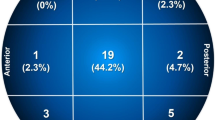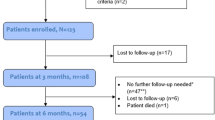Abstract
Purpose
Percutaneous compression plate (PCCP) provides superior anti-rotational abilities and mechanical strength in femoral neck fractures (FNFs). The first series reporting its utilization of FNFs was promising. Since the long-term outcome regarding the implant has not been reported, the purpose of this study was to evaluate the long-term functional outcomes and complications after fixation using PCCP in FNFs.
Materials and methods
From 2010 to 2019, 51 patients aged from 18 to 87 years were evaluated; 11 patients were excluded from this study. Demographic data, fracture classification, and complications were analyzed. Besides plain radiographs and CT, uptake ratios using bone scintigraphy and/or SPECT were also collected and analyzed.
Results
At a mean follow-up of 4.4 ± 2.0 years (range, 2–10 years), the mean Harris hip score was 88, with 44 patients (86.3%) achieving excellent or good outcomes. The rate of complication was 13.7% (7/51), with five cases of osteonecrosis of the femoral head (OFNH). Hip replacements were performed in four (7.8%) cases. After confirmation of normal transfusion status, 11 patients underwent elective removal of the implant without further complications.
Conclusion
Closed reduction and internal fixation using PCCP in FNFs resulted in satisfactory outcomes with low complication rates. Longer follow-up (3–5 years) and sequential bone scintigraphy or SPECT after surgery are recommended after internal fixation using PCCP.




Similar content being viewed by others
Data availability
All data are available in the Department of Orthopedics of the First affiliated hospital of Soochow University.
References
Cooper C, Campion G, Melton LJ 3rd (1992) Hip fractures in the elderly: a world-wide projection. Osteoporos Int 2(6):285–289. https://doi.org/10.1007/bf01623184
Cheng SY, Levy AR, Lefaivre KA, Guy P, Kuramoto L, Sobolev B (2011) Geographic trends in incidence of hip fractures: a comprehensive literature review. Osteoporos Int 22(10):2575–2586. https://doi.org/10.1007/s00198-011-1596-z
Bhandari M, Swiontkowski M (2017) Management of acute hip fracture. N Engl J Med 377(21):2053–2062. https://doi.org/10.1056/NEJMcp1611090
Fixation using alternative implants for the treatment of hip fractures I.(2017) Fracture fixation in the operative management of hip fractures (FAITH): an international, multicentre, randomised controlled trial. Lancet. 389(10078):1519-1527.https://doi.org/10.1016/S0140-6736(17)30066-1
Slobogean GP, Sprague SA, Scott T, Bhandari M (2015) Complications following young femoral neck fractures. Injury 46(3):484–491. https://doi.org/10.1016/j.injury.2014.10.010
Parker MJ, Stedtfeld HW (2010) Internal fixation of intracapsular hip fractures with a dynamic locking plate: initial experience and results for 83 patients treated with a new implant. Injury 41(4):348–351. https://doi.org/10.1016/j.injury.2009.09.004
Xiao YP, Shu DP, Bei MJ, Ji T, Kan WS, Li SG (2018) The clinical application of a novel method of internal fixation for femoral neck fractures-dynamic locking compression system. J Orthop Surg Res 13(1):131. https://doi.org/10.1186/s13018-018-0827-9
Gotfried Y (2000) Percutaneous compression plating of intertrochanteric hip fractures. J Orthop Trauma 14(7):490–495. https://doi.org/10.1097/00005131-200009000-00005
Brandt SE, Lefever S, Janzing HM, Broos PL, Pilot P, Houben BJ (2002) Percutaneous compression plating (PCCP) versus the dynamic hip screw for pertrochanteric hip fractures: preliminary results. Injury 33(5):413–418. https://doi.org/10.1016/s0020-1383(02)00080-3
Gotfried Y (2002) Percutaneous compression plating for intertrochanteric hip fractures: treatment rationale. Orthopedics 25(6):647–652
Gotfried Y, Cohen B, Rotem A (2002) Biomechanical evaluation of the percutaneous compression plating system for hip fractures. J Orthop Trauma 16(9):644–650. https://doi.org/10.1097/00005131-200210000-00006
Peyser A, Weil Y, Brocke L, Manor O, Mosheiff R, Liebergall M (2005) Percutaneous compression plating versus compression hip screw fixation for the treatment of intertrochanteric hip fractures. Injury 36(11):1343–1349. https://doi.org/10.1016/j.injury.2004.09.014
Brandt E, Verdonschot N, van Vugt A, van Kampen A (2006) Biomechanical analysis of the percutaneous compression plate and sliding hip screw in intracapsular hip fractures: experimental assessment using synthetic and cadaver bones. Injury 37(10):979–983. https://doi.org/10.1016/j.injury.2006.05.011
Mukherjee P, Ashworth MJ (2010) A new device to treat intra-capsular fracture neck of femur non-union. Strategies Trauma Limb Reconstr 5(3):159–162. https://doi.org/10.1007/s11751-010-0096-6
Zhu F, Liu G, Shao HG (2015) Treatment of femoral neck fracture with percutaneous compression plate: preliminary results in 74 patients. Orthop Surg 7(2):132–137. https://doi.org/10.1111/os.12170
Kazley JM, Banerjee S, Abousayed MM, Rosenbaum AJ (2018) Classifications in brief: garden classification of femoral neck fractures. Clin Orthop Relat Res 476(2):441–445. https://doi.org/10.1007/s11999.0000000000000066
Garden RS (1961) Low-angle fixation in fractures of the femoral neck. J Bone Joint Surg Br Vol 43(4):647–663
Bartonicek J (2001) Pauwels’ classification of femoral neck fractures: correct interpretation of the original. J Orthop Trauma 15(5):358–360. https://doi.org/10.1097/00005131-200106000-00009
Harris WH (1969) Traumatic arthritis of the hip after dislocation and acetabular fractures: treatment by mold arthroplasty An end-result study using a new method of result evaluation. J Bone Joint Surg Am 51(4):737–755
Parker M, Cawley S, Palial V (2013) Internal fixation of intracapsular fractures of the hip using a dynamic locking plate: two-year follow-up of 320 patients. Bone Joint J 95-b(10):1402–1405. https://doi.org/10.1302/0301-620x.95b10.31511
Gellman YN, Khoury A, Liebergall M, Mosheiff R, Weil YA (2019) Outcome of femoral fractures in poliomyelitis patients. Int Orthop 43(11):2607–2612. https://doi.org/10.1007/s00264-019-04285-2
Hoshino CM, Christian MW, O’Toole RV, Manson TT (2016) Fixation of displaced femoral neck fractures in young adults: fixed-angle devices or Pauwel screws? Injury 47(8):1676–1684. https://doi.org/10.1016/j.injury.2016.03.014
Yin Q, Gu S, Wang J, Li H (2016) Prospective randomized controlled study on treatment of displaced femoral neck fractures with percutaneous compression plate. Zhongguo Xiu Fu Chong Jian Wai Ke Za Zhi 30(8):951–955. https://doi.org/10.7507/1002-1892.20160193
Chen Y, Li H, Dai L, Yin Q, Li D, Wang X (2021) Imaging observation of percutaneous compression plate use in promoting femoral neck fracture healing. J Int Med Res 49(8):3000605211033501. https://doi.org/10.1177/03000605211033501
Xu JL, Liang ZR, Xiong BL (2019) Risk factors associated with osteonecrosis of femoral head after internal fixation of femoral neck fracture:a systematic review and meta-analysis. Bmc Musculoskelet Disord 20(1):632. https://doi.org/10.1186/s12891-019-2990-5
Gotfried Y, Kovalenko S, Fuchs D (2013) Nonanatomical reduction of displaced subcapital femoral fractures (Gotfried reduction). J Orthop Trauma 27(11):e254-259. https://doi.org/10.1097/BOT.0b013e31828f8ffc
Weinrobe M, Stankewich CJ, Mueller B, Tencer AF (1998) Predicting the mechanical outcome of femoral neck fractures fixed with cancellous screws: an in vivo study. J Orthop Trauma 12(1):27–36. https://doi.org/10.1097/00005131-199801000-00005
Duckworth AD, Bennet SJ, Aderinto J, Keating JF (2011) Fixation of intracapsular fractures of the femoral neck in young patients: risk factors for failure. J Bone Joint Surg Br 93(6):811–816. https://doi.org/10.1302/0301-620x.93b6.26432
Wen Z, Lin Z, Yan W, Zhang J (2017) Influence of cigarette smoking on osteonecrosis of the femoral head (ONFH): a systematic review and meta-analysis. Hip Int 27(5):425–435. https://doi.org/10.5301/hipint.5000516
Yuan HF, Shen F, Zhang J, Shi HC, Gu YS, Yan ZQ (2015) Predictive value of single photon emission computerized tomography and computerized tomography in osteonecrosis after femoral neck fracture: a prospective study. Int Orthop 39(7):1417–1422. https://doi.org/10.1007/s00264-015-2709-7
Yoon JY, Lee SJ, Yoon KS, Yoon PW (2020) The diagnostic value of SPECT/CT in predicting the occurrence of osteonecrosis following femoral neck fracture: a prospective cohort study. Bmc Musculoskelet Disord 21(1):517. https://doi.org/10.1186/s12891-020-03538-1
Fan W Zhu L Chen J Guo C Yan Z.(2017) Identifying Patients who will most benefit from single photon emission computerized tomography and computerized tomography after femoral neck fracture. Med Sci Monit. 23):5669–5674. https://doi.org/10.12659/msm.904026.
Sonne-Holm S, Nordkild P, Dyrbye M, Jensen JS (1987) The predictive value of bone scintigraphy after internal fixation of femoral neck fractures. Injury 18(1):33–35. https://doi.org/10.1016/0020-1383(87)90382-2
Wang T, Sun JY, Zha GC, Jiang T, You ZJ, Yuan DJ (2014) Analysis of risk factors for femoral head necrosis after internal fixation in femoral neck fractures. Orthopedics 37(12):e1117-1123. https://doi.org/10.3928/01477447-20141124-60
Biber R, Brem M, Bail HJ (2014) Targon Femoral Neck for femoral-neck fracture fixation: lessons learnt from a series of one hundred and thirty five consecutive cases. Int Orthop 38(3):595–599. https://doi.org/10.1007/s00264-013-2176-y
Alshameeri Z, Elbashir M, Parker MJ (2017) The outcome of intracapsular hip fracture fixation using the Targon Femoral Neck (TFN) locking plate system or cannulated cancellous screws: a comparative study involving 2004 patients. Injury 48(11):2555–2562. https://doi.org/10.1016/j.injury.2017.08.063
Cheng T, Zhang GY, Liu T, Zhang XL (2012) A meta-analysis of percutaneous compression plate versus sliding hip screw for the management of intertrochanteric fractures of the hip. J Trauma Acute Care Surg 72(5):1435–1443. https://doi.org/10.1097/TA.0b013e318247252a
Funding
The authors did not receive support from any organization for the submitted work.
Author information
Authors and Affiliations
Contributions
All authors contributed to the study’s conception and design. Material preparation, data collection, and analysis were performed by Zhe-Yu Jin and Chao Gu. The original draft of the manuscript was written by Zhe-Yu Jin. Hui-Lin Yang and Ming Xu revised the draft. All authors read and approved the final manuscript.
Corresponding author
Ethics declarations
Ethics approval
All procedures performed in studies involving human participants were in accordance with the ethical standards of the institutional and/or national research committee and with the 1964 Helsinki Declaration and its later amendments or comparable ethical standards. The study was approved institutional review board at the First Affiliated Hospital of Soochow University (IRB#2021–176).
Consent to participate
Informed consent was obtained from all individual participants included in the study.
Consent for publication
Patients signed informed consent regarding publishing their data and imaging materials.
Conflict of interest
The authors declare no competing interests.
Additional information
Publisher's note
Springer Nature remains neutral with regard to jurisdictional claims in published maps and institutional affiliations.
Rights and permissions
About this article
Cite this article
Jin, ZY., Gu, C., Yang, HL. et al. Outcome of percutaneous compression plate for treatment of femoral neck fractures: mean follow-up of 4.4 years. International Orthopaedics (SICOT) 46, 1891–1898 (2022). https://doi.org/10.1007/s00264-022-05405-1
Received:
Accepted:
Published:
Issue Date:
DOI: https://doi.org/10.1007/s00264-022-05405-1




